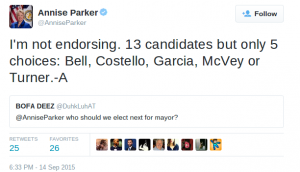Don penned an excellent article regarding flooding the other day. It was dealing with flooding from the bayous which is categorized as river flooding. That’s one part of the flooding problem. The rain tax is supposed to deal with the other end of flooding, the sheet flooding. Sheet flooding is colloquially referred to as street flooding. Specifically, it’s the flooding that occurs when sheet flow causes flooding as opposed to river flooding. If I understand the rain tax correctly, and there’s a good chance I do not since I only moved into the city 14 months ago, Costello is in charge of remedying the actual sheet flooding.
The USDA Conservation Engineering Division released Technical Report 55 (PDF file)back in the 1980s which is a good guide to use in assessing how sheet flow runoff can be impacted. The basic formula is:
Q = (P – Ia ) squared/
(P – Ia ) + S
For small watersheds like the ones in Houston the Ia value is 0.2S yielding a working formula of
Q = (P – 0.2S) squared/
(P +0.8S)
S is the variable that can remedy the amount of sheet flooding, and in turn can remedy the amount of bayou flooding. S is the amount of potential maximum retention after runoff begins.
S is plugged into a curve analysis to show how much runoff to expect as precipitation increases. The greater the precipitation, the greater the impact S will have. The question becomes what can Costello do in order to decrease the curve number so there’s less runoff. Or put another way, what can be done via the rain tax to retain or disrupt runoff so that houses don’t flood from the rain, which in turn will keep the bayous from filling as much and lower the magnitude of river flooding. The higher the curve number in the analysis, the greater the sheet flow. So in order to reduce flooding the curve number needs to be lowered.
No sweeping change can take place that will end the flood threat, but several piecemeal steps can be taken to decrease the curve number.
Paved areas have a curve number of 98
Curb and gutter roadways have a 98 also.
Now, this can be reduced by simple design change when redoing the roads such as what is currently occurring on Fondren. The road construction can be done with the new roadway having both curb and gutter system as well as metal grates with pipes connect into the gutter drainage. Since the construction will already be ongoing it’s simply a matter of planning for the pipes and grates. It’s also likely a small cost as the roads are already being busted out and rebuilt from the ground up. Simply dig a hole and accompanying trench for the pipe, add the pipe and grate, and it’s done. This will generate extra drainage that will assist in keeping the known street flooding areas passable as well as reducing the overall runoff from the storms. Both traffic flow as well as runoff problems are reduced.
The same can be accomplished in the permitting for new buildings. Grant the permits, but also require that the paved areas, parking lots for example, have a grate and pipe drain into the storm drainage system. The rain tax can bear the cost of the piping, the business simply has to make the grate space available.
A second area that can be addressed in a small cost manner is elevated medians. Any paved elevated median could have the frame remain paved, but the interior busted out and replaced with sand and grass. This reduces the curve number significantly as sand and good grass cover would have a curve number of 39 rather than 98. In a 10 inch rain the runoff for the grass on sand area is reduced from 9.76 inches to 2.23 inches.
This could be coupled with a “beautify Houston” or some such campaign where businesses are encouraged to green the areas on the peripheries of their parking lots. The rain tax could be used for grants to cover the removal of pavement and placement of sand/grass. Of if the business can bear the cost the city can handle the hauling away of the pavement. You get the idea.
In the end, I have no idea how much runoff this will eliminate, but at least the taxes are being used for their intended purposes and the flooding problem is reduced. We’re never going to be able to make the city flood proof, but if the flooding level can be reduced 2-5{997ab4c1e65fa660c64e6dfea23d436a73c89d6254ad3ae72f887cf583448986} then that’s the difference between flooding and not flooding for the last row of houses that are flooded in the current events. It’s the difference between the water line being above or blow the power outlets in houses so the repair cost is reduced in flooding.



